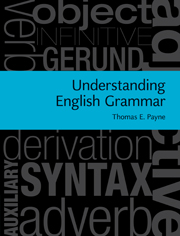Book contents
- Frontmatter
- Contents
- List of figures
- List of tables
- Preface
- Acknowledgements
- List of typographical conventions and abbreviations
- Introduction
- 1 History
- 2 Typology
- 3 The lexicon
- 4 Morphology – the shapes of words
- 5 Participant reference
- 6 Actions, states, and processes
- 7 Basic concepts in English syntax
- 8 Advanced concepts in English syntax
- 9 Complementation
- 10 Modification
- 11 Auxiliaries and the “black hole” of English syntax
- 12 Time and reality
- 13 Voice and valence
- 14 Clause combining
- 15 Pragmatic grounding and pragmatically marked constructions
- Glossary
- Endnotes
- References
- Index
Introduction
Published online by Cambridge University Press: 05 June 2012
- Frontmatter
- Contents
- List of figures
- List of tables
- Preface
- Acknowledgements
- List of typographical conventions and abbreviations
- Introduction
- 1 History
- 2 Typology
- 3 The lexicon
- 4 Morphology – the shapes of words
- 5 Participant reference
- 6 Actions, states, and processes
- 7 Basic concepts in English syntax
- 8 Advanced concepts in English syntax
- 9 Complementation
- 10 Modification
- 11 Auxiliaries and the “black hole” of English syntax
- 12 Time and reality
- 13 Voice and valence
- 14 Clause combining
- 15 Pragmatic grounding and pragmatically marked constructions
- Glossary
- Endnotes
- References
- Index
Summary
The harmony between thought and reality is to be found in the grammar of the language … Uttering a word is like striking a note on the keyboard of the imagination.
Ludwig Wittgenstein (1981[1958])Language gives form to thought. Thought itself is hidden, internal, intangible, whereas language seems to be external, physical, exposed for all the world to see and hear. But is it really? Certainly the noises we make when we communicate using spoken language are “external” in that they are physical modifications of the mind–external environment in the form of complex sound waves moving through air. But the noises themselves are not the essence of our language. We often think in language without overt expression. When we write, we say we are writing “in a language,” even though the medium is visible marks (or pixels) rather than noises. Signed languages used by the deaf are still languages, though they don't rely on sounds at all. The forms of language are certainly not random, like the sound of water tumbling over rocks in a stream. Regardless of the form it takes, language is governed by complex underlying patterns. If there were no consistent patterns, people would not be able to communicate with one another, and, after all, language is all about communication. It is the harmony between underlying patterns and external expression that is the essence of language.
- Type
- Chapter
- Information
- Understanding English GrammarA Linguistic Introduction, pp. 1 - 20Publisher: Cambridge University PressPrint publication year: 2010



